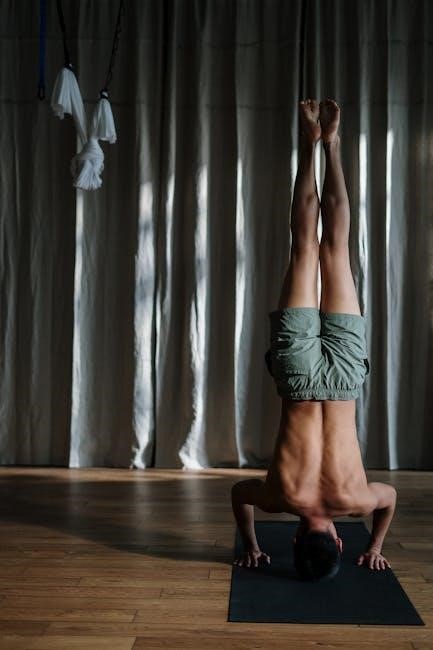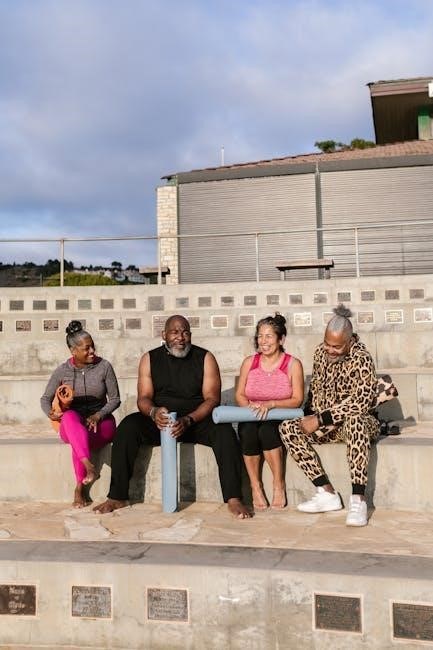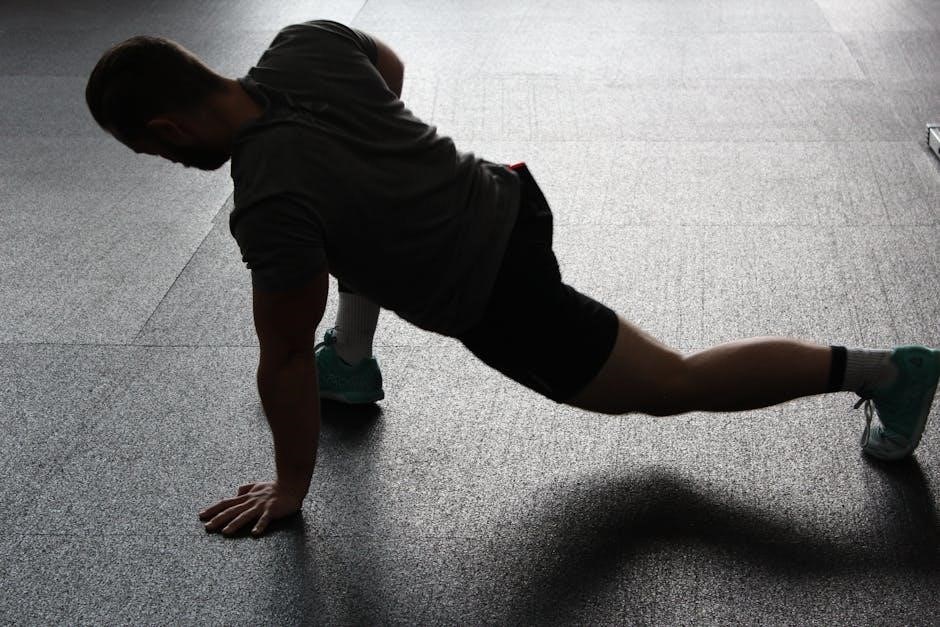Seated core exercises are a practical and accessible way to strengthen abdominal muscles‚ improve posture‚ and enhance overall stability. Perfect for seniors or those with mobility challenges‚ these exercises can be done anywhere with minimal equipment‚ offering numerous health benefits and improving daily functionality.
Overview of the Importance of Core Strength
Core strength is essential for maintaining proper posture‚ balance‚ and overall physical stability. A strong core‚ including abdominal and back muscles‚ supports daily activities‚ improves mobility‚ and reduces the risk of injuries. It enhances athletic performance and helps with heavy lifting by providing a stable base. Weak core muscles can lead to poor posture‚ back pain‚ and limited mobility. Strengthening the core through exercises like seated crunches or trunk rotations can improve balance and reduce the risk of falls‚ especially in older adults. A strong core also promotes better breathing and digestion. Incorporating core exercises into a fitness routine is vital for long-term health and independence‚ making it a foundational element of any effective workout plan.
Benefits of Seated Core Exercises for Seniors
Seated core exercises offer numerous benefits for seniors‚ including improved strength‚ mobility‚ and balance; These exercises are low-impact and can be done from a chair‚ making them ideal for those with limited mobility. They help strengthen abdominal muscles‚ which supports better posture and reduces back pain. Enhanced core stability can also reduce the risk of falls‚ a common concern among seniors. Additionally‚ seated exercises can boost metabolism‚ improve circulation‚ and increase energy levels. They are versatile and can be adapted to different fitness levels‚ providing a safe and effective way to stay active. Regular practice can also improve mental health by promoting a sense of accomplishment and independence‚ making them a valuable addition to a senior’s fitness routine.

Popular Seated Core Exercises
Popular seated core exercises include crunching knee raises‚ seated trunk rotations‚ and leg raises. These exercises target abdominal muscles‚ improve posture‚ and enhance stability with minimal equipment.
Crunching Knee Raises
Crunching knee raises are an effective seated exercise targeting the abdominal muscles. Sit tall with hands behind your head or at your sides. Bend one knee toward your chest and curl your upper body to meet it. Hold briefly‚ then lower and repeat with the other knee. This exercise strengthens the abs‚ improves flexibility‚ and enhances core stability. It’s ideal for seniors as it’s low-impact and can be done without equipment. Proper form ensures engagement of the core muscles‚ promoting better posture and reducing strain on the lower back. Regular practice helps improve mobility and overall core strength‚ essential for daily activities and independence.
Seated Trunk Rotation
Seated trunk rotation is a simple yet effective exercise for improving spinal mobility and core strength. Sit upright in a sturdy chair with feet flat on the floor. Place your hands on your shoulders or clasp them together in front of your chest. Slowly rotate your torso to one side‚ keeping your hips facing forward. Hold briefly‚ then return to the starting position and repeat on the other side. This exercise enhances spinal flexibility‚ strengthens oblique muscles‚ and improves posture. It’s particularly beneficial for seniors‚ as it helps maintain range of motion and reduces the risk of back pain. Perform with controlled movements to avoid strain‚ ensuring proper engagement of the core muscles throughout the exercise.
Leg Raises and Cycling Crunches
Leg raises and cycling crunches are excellent seated core exercises that target the abdominal muscles‚ particularly the lower abs. For leg raises‚ sit tall in a chair‚ lift one bent leg toward your chest‚ and curl your upper body to meet your knee. Hold briefly‚ then lower and repeat with the other leg. Cycling crunches involve mimicking the motion of pedaling a bicycle while seated‚ bringing one elbow toward the opposite knee as you twist your torso. These exercises improve core strength‚ enhance flexibility‚ and engage the obliques. Perform with controlled movements to avoid strain‚ ensuring proper engagement of the core muscles throughout. Both exercises are effective for strengthening the lower abs and improving overall core stability‚ making them ideal for incorporating into a seated workout routine.

Stability and Balance Exercises
Seated stability exercises improve posture‚ reduce fall risk‚ and enhance core strength. They involve controlled movements‚ often using a chair‚ to engage muscles and promote balance effectively.
Chair-Based Stability Exercises
Chair-based stability exercises are excellent for improving balance and core strength while seated. They often involve simple movements like shifting weight‚ extending legs‚ or twisting the torso. These exercises are particularly beneficial for seniors‚ as they enhance posture and reduce the risk of falls. Many routines require no equipment‚ making them ideal for home or office use. For example‚ seated crunches or leg raises target the abdominals while maintaining stability. Proper posture is essential‚ with shoulders back and spine aligned. Engaging the core during these movements ensures effectiveness. Over time‚ these exercises can improve overall balance and coordination‚ making daily activities easier. They are a great way to stay active and healthy‚ even with limited mobility. Incorporating them into a daily routine promotes long-term stability and independence.
Seated Arm and Leg Movements
Seated arm and leg movements are effective exercises for engaging the core while improving coordination and flexibility. These exercises involve extending arms or legs while maintaining balance. For example‚ lifting one arm overhead and the opposite leg toward the chest works the obliques and hip flexors. Alternating sides ensures a balanced workout. Another variation is holding a dumbbell while performing seated twists‚ which strengthens the abdominal muscles. Proper form is crucial‚ with a tall posture and engaged core throughout each movement. These exercises are versatile and can be modified to suit different fitness levels‚ making them ideal for seniors or those with mobility limitations. Regular practice enhances stability‚ improves posture‚ and boosts overall physical confidence. Incorporating these movements into a routine can lead to better mobility and reduced risk of injury. They are easy to perform and require minimal space‚ making them perfect for home or office workouts. Consistency is key to achieving lasting benefits.

Using Resistance Bands for Seated Core Workouts
Resistance bands add intensity to seated core exercises‚ targeting abs and obliques. Loop the band around a sturdy object or hold it in hands for effective engagement.
Enhancing Core Strength with Resistance Bands
Resistance bands are a versatile tool for enhancing core strength during seated workouts. They can be anchored to a stable object or held manually to increase tension. By incorporating bands into exercises like seated crunches or trunk rotations‚ you can challenge your muscles more effectively. The bands provide continuous resistance‚ which helps in building endurance and muscle tone. They are particularly beneficial for targeting the deeper abdominal muscles‚ which are essential for stability and balance. Additionally‚ resistance bands are lightweight and portable‚ making them ideal for home or travel workouts. Regular use can lead to improved posture‚ reduced back pain‚ and enhanced overall core stability.
Trainer Tips for Effective Seated Core Sessions
Focus on proper posture‚ engage your core muscles‚ and maintain controlled movements. Use breathing techniques to enhance stability. Start with low repetitions and gradually increase intensity.
Proper Posture and Engagement of Core Muscles
Maintaining proper posture is essential for effective seated core exercises. Sit tall with feet flat on the floor‚ shoulders relaxed‚ and chest lifted. Engage your core by drawing your belly button toward your spine‚ creating a stable base for movement. Avoid slouching or arching your back‚ as this can strain muscles and reduce exercise effectiveness. Consistent core engagement helps target the right muscles and prevents injury. Proper breathing is also crucial—inhale to prepare‚ exhale during effort‚ and avoid holding your breath. Focus on slow‚ controlled movements to maximize results and ensure safety.

Incorporating Seated Core Exercises into Daily Routine
Incorporating seated core exercises into your daily routine is simple and beneficial‚ especially for those with limited mobility. Start with short sessions‚ such as 5-10 minutes‚ and gradually increase as you build strength. These exercises can be done during work breaks‚ while watching TV‚ or even during commutes. Consistency is key—aim for 3-4 times per week. Begin with basic movements like seated crunches or leg raises and progress to more challenging exercises. Printable PDF guides offer structured routines‚ making it easy to follow along. Over time‚ these exercises can improve posture‚ reduce back pain‚ and boost overall energy levels‚ fitting seamlessly into your lifestyle for lasting health benefits.